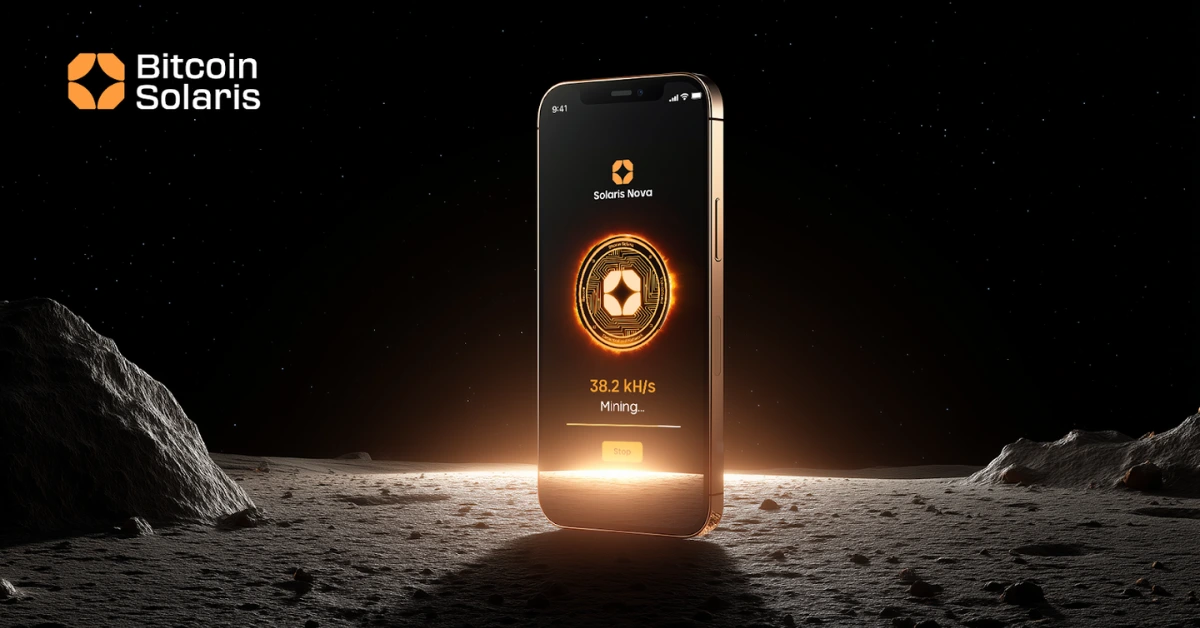
Cardano’s staking model has long been praised for stability and predictable returns—but it’s still a passive process. Stakers delegate. Pools manage. Rewards arrive on delay. There’s no mining, no real-time participation, and little room for entry-level users to impact the network.
That’s why Bitcoin Solaris’s upcoming smartphone mining system is attracting attention — even from Cardano’s developer circles. The project’s architecture, which combines Proof-of-Capacity with adaptive mining logic, introduces something rare in crypto: decentralized mining that can run directly on a mobile device. Some Cardano contributors have publicly described it as “revolutionary” in both accessibility and design.
And they’re not wrong.
At the center of this innovation is the Solaris Nova App — a mobile-first interface that will allow users to mine BTC-S tokens with no external hardware, no staking minimums, and no technical setup. Mining occurs through a lightweight plotting system. Users allocate a small amount of device storage (typically 1–5 GB) and idle CPU cycles to complete consensus operations, validating transactions and earning rewards.
This isn’t theoretical. It’s powered by the Helios Consensus Mechanism, which combines four components:
The system is adaptive. It scales mining tasks based on device capability — whether a smartphone, desktop, or server — and adjusts difficulty accordingly. That means every device on the network can participate without being forced into a fixed role.
To see how the system works in context — and why developer attention is growing — check out this breakdown from Crypto Chino.
Cardano users can stake ADA, but only by handing it off to a pool. There’s no local validation. No native mining. And while ADA holders earn rewards, they don’t influence finality or block production directly.
Bitcoin Solaris shifts that balance. With mobile mining, users actively contribute to security. Every Nova App user is part of the consensus process. And because rewards are earned through action — not delegation — the system remains more decentralized at the edge.
This difference has drawn attention from blockchain engineers who’ve long considered Cardano’s staking system an endpoint. In contrast, Bitcoin Solaris introduces a beginning: a way for proof-based participation to live on devices users already own.
The Nova App is scheduled for release soon, with direct wallet integration and live mining functionality. Users will be able to begin mining BTC-S from any supported smartphone. No complicated config, and no custom wallet requirement.
Behind the scenes, the project has already completed full verification:
Consensus mechanics, staking contracts, and mining logic are all open source and verified. Nothing hidden.
Bitcoin Solaris has a fixed total supply of 21 million BTC-S tokens, and only 4.2 million (20%) are available in the presale. Phase 1 is now closed. In Phase 2, tokens are priced at 2 USDT each.
There are no backdoor discounts, no private allocations. Once the presale closes, BTC-S moves to open market pricing.
1 — Visit bitcoinsolaris.com
This is the verified presale portal and project dashboard. Use it to access all official tools and timelines.
2 — Connect a Solana-Compatible Wallet
BTC-S runs on Solana. Phantom and Solflare are fully supported.
3 — Purchase BTC-S at 2 USDT per Token
This is the current presale rate. Tokens are delivered instantly upon confirmation.
4 — Prepare for Nova App Launch
Once live, the app will allow you to mine BTC-S directly from your phone with no special hardware required.
5 — Stake, Mine, or Hold
BTC-S tokens are usable immediately. Stake them, prepare for mining, or hold and monitor price dynamics.
6 — Follow Project Updates
Stay informed about staking rewards, app release, and validator onboarding via Telegram and X
Cardano proved that staking could be decentralized. Bitcoin Solaris proves that mining can be, too. And now that mobile mining is real and imminent, even blockchain veterans are paying attention.
Website: https://bitcoinsolaris.com/
X: https://x.com/BitcoinSolaris
Telegram: https://t.me/Bitcoinsolaris
The content featured on Coinpedia's press release page is provided for informational purposes only. Coinpedia does not endorse, verify, or take responsibility for the accuracy, completeness, or reliability of any press releases or associated materials. Any views, opinions, or statements expressed in these press releases are those of the respective issuers and do not reflect the opinions or positions of Coinpedia. Coinpedia is not liable for any content, products, services, or actions mentioned in the press releases. Readers should independently verify the information before taking any actions related to the subject matter of the releases.
The Pakistan government has accelerated its web3 adoption through a strategic collaboration with Binance. The…
The crypto market turned red today as the majority of tokens recorded almost no gains…
Ripple CEO Brad Garlinghouse announced on X that the company has received conditional approval from…
Bitcoin continued to trade in a narrow range on Monday, with price action showing little…
An interesting debate around XRP has resurfaced after ETF analyst Nate Geraci raised a question…
Ripple, a leading crypto-focused fintech company, has partnered with AMINA Bank to enable near real-time…